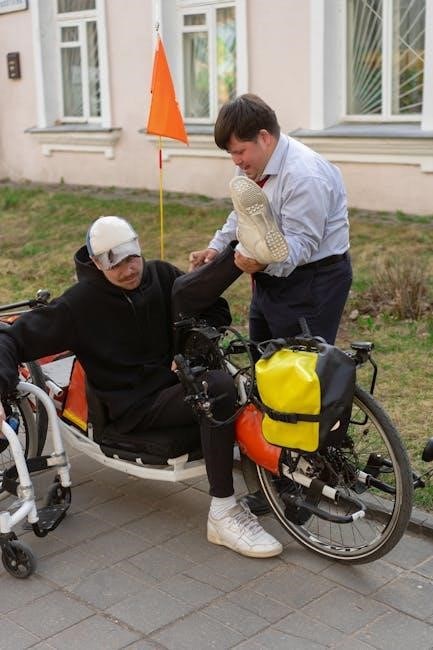Tarsal Tunnel Syndrome involves compression of the posterior tibial nerve near the ankle‚ causing pain‚ numbness‚ and tingling. It mirrors carpal tunnel syndrome but affects the foot.
Definition and Overview
Tarsal Tunnel Syndrome (TTS) is a compressive neuropathy of the posterior tibial nerve as it traverses the tarsal tunnel on the inner side of the ankle. It mimics carpal tunnel syndrome but affects the foot. Symptoms include pain‚ numbness‚ and tingling along the nerve’s distribution. The condition often results from repetitive stress‚ swelling‚ or structural abnormalities. Early diagnosis is crucial to prevent chronic pain and nerve damage. Physical therapy plays a central role in managing TTS‚ focusing on reducing nerve compression and restoring functional mobility. Understanding the condition’s mechanics is vital for effective treatment and rehabilitation strategies;
Causes and Risk Factors
Tarsal Tunnel Syndrome (TTS) arises from compression of the posterior tibial nerve within the tarsal tunnel. Common causes include repetitive stress‚ swelling from injuries‚ or structural abnormalities like flat feet or abnormal bone growths. Risk factors involve activities that strain the foot‚ such as prolonged standing‚ running‚ or walking on uneven surfaces. Systemic conditions like diabetes or arthritis can also contribute by causing nerve inflammation. Obesity and poor footwear further exacerbate the risk. Identifying these factors is crucial for tailored treatment and prevention of chronic complications. Early intervention can significantly improve outcomes and restore normal functionality.
Symptoms and Diagnosis
Tarsal Tunnel Syndrome (TTS) typically presents with pain‚ numbness‚ and tingling along the inner side of the ankle and foot. Symptoms often worsen with activity and may improve with rest; In severe cases‚ muscle weakness can occur. Diagnosis involves clinical evaluation‚ including patient history and physical examination. The Tinel’s sign test‚ where tapping the nerve elicits symptoms‚ may be performed. Imaging studies like MRI or ultrasound can confirm nerve compression‚ while nerve conduction studies assess nerve function. Early diagnosis is crucial for effective treatment and preventing long-term nerve damage. Proper identification ensures timely intervention to alleviate discomfort and restore mobility.

Physical Therapy Exercises for Tarsal Tunnel Syndrome
Physical therapy plays a key role in managing Tarsal Tunnel Syndrome by improving flexibility‚ strength‚ and mobility. Exercises focus on stretching and strengthening the foot and ankle muscles to reduce discomfort and improve function. Regular practice helps alleviate symptoms and prevents further nerve compression‚ promoting long-term recovery and enhanced mobility.
Stretching Exercises
Stretching exercises are essential for alleviating symptoms of Tarsal Tunnel Syndrome by reducing tension on the posterior tibial nerve. Calf stretches‚ Achilles tendon stretches‚ and plantar fascia stretches are commonly recommended. These exercises help improve flexibility in the foot and ankle‚ reducing pressure on the nerve. Seated stretches and toe stretches can also be beneficial; Regular stretching can enhance blood flow‚ reduce stiffness‚ and prevent further nerve compression. Consistent practice of these exercises can lead to significant relief and improved mobility. It’s important to perform these stretches gently and hold each for 20-30 seconds to maximize effectiveness.

Strengthening Exercises
Strengthening exercises for Tarsal Tunnel Syndrome focus on improving muscle support around the foot and ankle. Toe curls using resistance bands and marble pick-up exercises can enhance intrinsic foot muscle strength. Ankle weight exercises and heel raises are also beneficial for building lower leg and foot stability. These exercises help stabilize the foot and reduce strain on the posterior tibial nerve‚ alleviating symptoms. Consistent practice of strengthening exercises can improve arch support and overall foot mechanics‚ reducing the risk of nerve compression and promoting long-term relief. Regular strengthening routines are a key component of managing Tarsal Tunnel Syndrome effectively.
Balance and Proprioception Training
Balance and proprioception training is essential for improving foot and ankle stability in Tarsal Tunnel Syndrome. Exercises like single-leg stands‚ heel-to-toe walking‚ and balance board activities enhance neuromuscular control. Proprioception drills‚ such as ankle weight shifts and mini-trampoline work‚ help restore sensory feedback. These exercises reduce instability‚ minimize nerve irritation‚ and promote functional mobility. By strengthening the body’s awareness of foot positioning‚ balance training supports long-term recovery and prevents recurrence. Incorporating these exercises into a daily routine can significantly improve overall foot function and reduce symptoms. Consistency is key to achieving lasting benefits.
Massage and Soft Tissue Mobilization
Massage and soft tissue mobilization are key components in managing Tarsal Tunnel Syndrome. Techniques like deep tissue massage and myofascial release help reduce tension around the posterior tibial nerve‚ improving circulation and relieving pressure. Regular massage can also break down adhesions in the flexor retinaculum‚ the ligament forming the tarsal tunnel. Additionally‚ manual therapy enhances flexibility in the surrounding muscles and connective tissues‚ reducing nerve compression. These methods are often combined with stretching exercises to promote recovery and prevent future episodes. Consistency in therapy is crucial for long-term relief and optimal foot function.
Joint Mobilization and Manipulation
Joint mobilization and manipulation are effective techniques to address Tarsal Tunnel Syndrome by improving joint mobility and reducing stiffness. These methods focus on gently moving the joints of the foot and ankle to relieve pressure on the posterior tibial nerve. Manipulation can help restore normal joint mechanics‚ while mobilization enhances nerve gliding and reduces tension in surrounding tissues. Regular joint mobilization can also improve proprioception and balance‚ supporting overall foot function. When performed by a trained therapist‚ these techniques can significantly alleviate symptoms and complement other therapeutic exercises for comprehensive recovery. Consistency is key to achieving lasting relief.

Ergonomic Modifications and Footwear Recommendations
Proper footwear with good arch support and cushioning can alleviate Tarsal Tunnel Syndrome symptoms. Orthotics and ergonomic adjustments to workstations or activities help reduce nerve compression and promote healing.
Proper Footwear Selection
Choosing the right footwear is crucial for managing Tarsal Tunnel Syndrome. Opt for shoes with excellent arch support‚ cushioning‚ and a wide toe box to reduce pressure on the posterior tibial nerve. Avoid high heels or tight-fitting shoes that can exacerbate symptoms. Orthotic inserts or custom orthotics can provide additional support and alignment‚ helping to alleviate nerve compression. Shoes with soft‚ breathable materials and a rocker sole design can also promote comfort and reduce strain during walking or standing. Proper footwear selection‚ combined with physical therapy‚ can significantly improve mobility and reduce discomfort associated with the condition.
Orthotic Devices and Support
Orthotic devices play a vital role in managing Tarsal Tunnel Syndrome by providing structural support and redistributing pressure. Custom orthotics are often recommended to address specific foot abnormalities‚ such as flat feet or excessive pronation‚ which can contribute to nerve compression. These devices help align the foot properly‚ reducing strain on the posterior tibial nerve. Rigid or semi-rigid orthotics are commonly used for their durability and effectiveness in correcting abnormal foot mechanics. By incorporating orthotic support into daily routines‚ individuals can alleviate symptoms and enhance the effectiveness of physical therapy exercises‚ promoting long-term relief and improved mobility.
When to Seek Medical Intervention
Persistent pain‚ severe symptoms‚ or lack of improvement with therapy warrant medical consultation. Conditions like nerve damage or structural issues may require surgical intervention or injections.
Indications for Surgery
Surgery is typically considered when conservative treatments fail to alleviate symptoms. Chronic pain‚ persistent numbness‚ or significant nerve damage may necessitate intervention. If physical therapy‚ orthotics‚ or injections do not provide relief‚ surgical decompression of the tibial nerve may be recommended. This procedure aims to relieve pressure on the nerve by releasing the tarsal tunnel ligament. Surgery is usually a last resort and is indicated for patients with severe‚ debilitating symptoms that impact daily activities and quality of life.
Role of Corticosteroid Injections
Corticosteroid injections are a common treatment for tarsal tunnel syndrome‚ reducing inflammation and nerve compression. Injected near the posterior tibial nerve‚ they aim to alleviate pain‚ numbness‚ and swelling. This non-surgical approach is often used when physical therapy or orthotics provide insufficient relief. While effective for short-term symptom management‚ injections may not address the underlying cause of nerve compression. They are typically recommended for patients who are not candidates for surgery or as a temporary solution to manage severe symptoms while other treatments are pursued.

Tarsal tunnel syndrome can be effectively managed with physical therapy‚ orthotics‚ and lifestyle modifications. Consistency in treatment and patient compliance are key to achieving long-term relief.
Physical therapy for tarsal tunnel syndrome offers significant benefits‚ including pain relief‚ improved mobility‚ and reduced nerve compression. Through targeted exercises like stretching and strengthening‚ patients can restore foot function and stability. Therapy also enhances proprioception‚ reducing the risk of further injury. Customized programs address individual needs‚ promoting long-term recovery and preventing symptom recurrence. By incorporating orthotics and ergonomic adjustments‚ physical therapy provides a holistic approach to managing the condition effectively. Regular adherence to prescribed exercises ensures sustained improvement and overall foot health.
Importance of Consistency and Compliance
Consistency and compliance are crucial for effective management of tarsal tunnel syndrome through physical therapy. Regular performance of prescribed exercises ensures progressive healing and prevents symptom relapse. Patients must adhere to their personalized treatment plans‚ including stretching‚ strengthening‚ and orthotic use. Skipping sessions or ignoring professional advice can hinder recovery and prolong discomfort. Compliance also involves lifestyle modifications‚ such as avoiding aggravating activities and wearing proper footwear. By maintaining discipline and following through with recommendations‚ individuals can achieve optimal outcomes and restore normal foot function more efficiently.